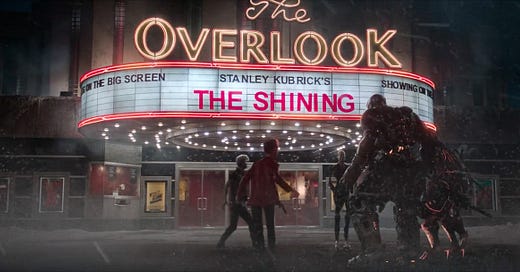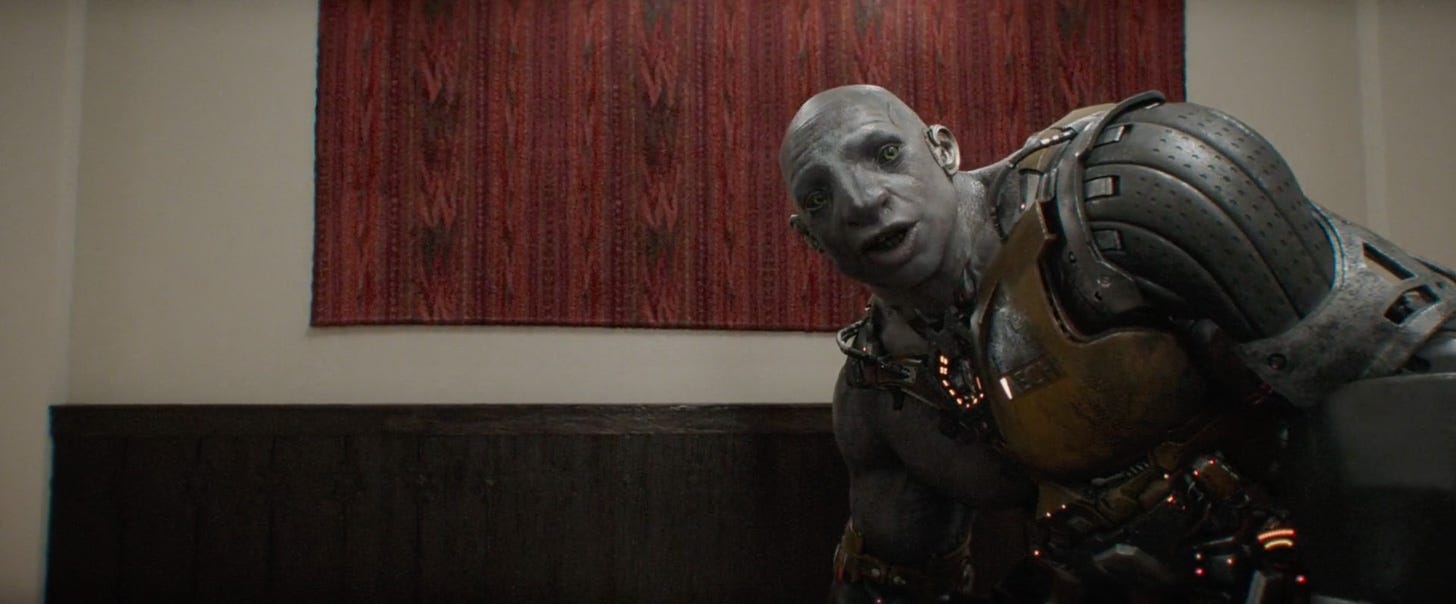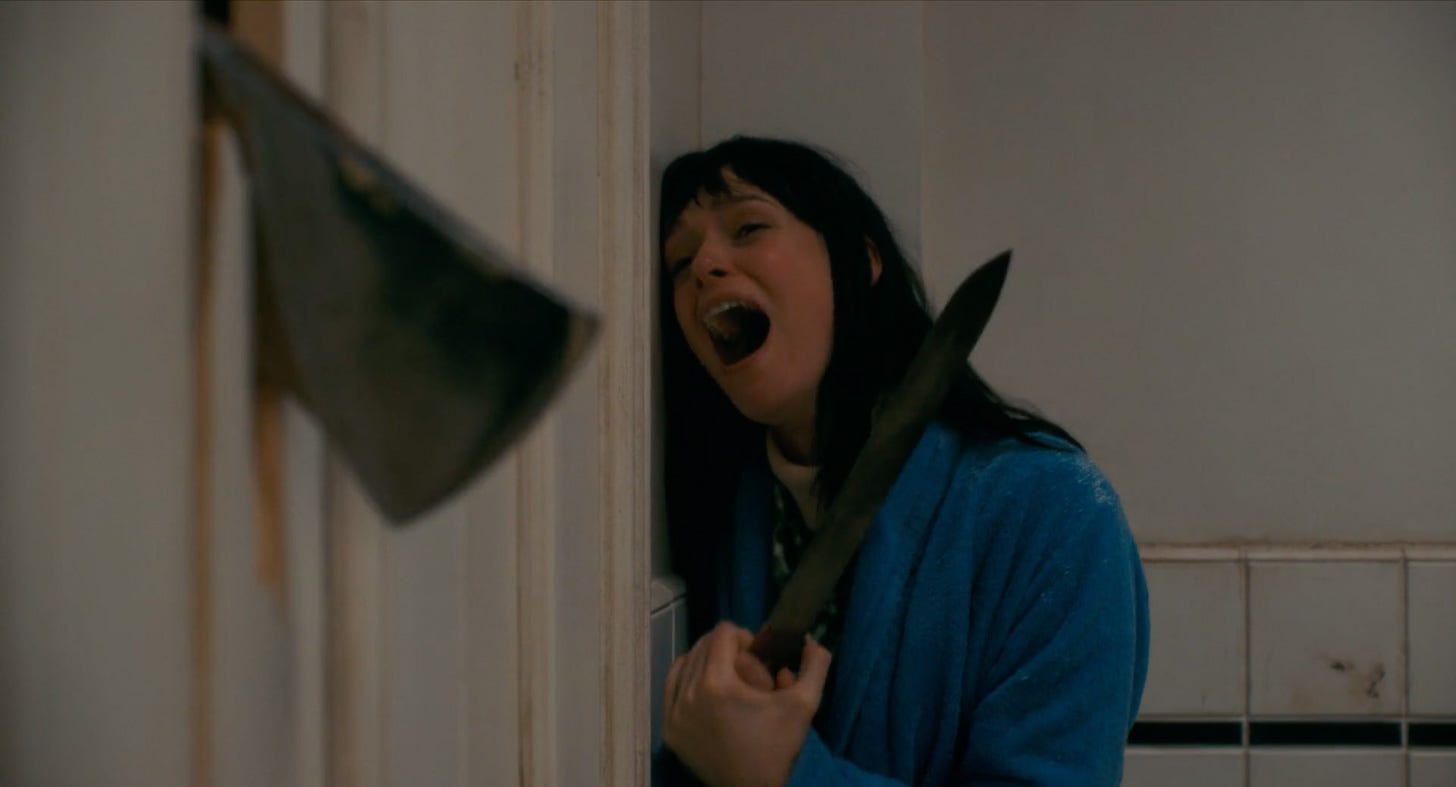The Afterlives of The Shining
On simulating Stanley Kubrick's film in Doctor Sleep and Ready Player One
Be forewarned, dear reader—sometime around the new year I will be publishing here a multipart series on ghost films, loosely organized around my video, Haunting (2020). Before that deluge of phantom-related content, however, I wanted to write about a film that I pointedly omitted from both the video and the essay: Stanley Kubrick’s The Shining (1980). Yes, I know, not another essay on an already over-analyzed film. But this post is not about The Shining, per se. It is about afterlives of The Shining as seen in two recent films, Doctor Sleep (2019) and Ready Player One (2018). Ready Player One is Steven Spielberg’s adaptation of the Ernest Cline’s 2011 bestselling sci-fi novel of the same name. Doctor Sleep is based on Stephen King’s sequel to his novel, The Shining—making that two unnecessary sequels in two different mediums. (At least the other unnecessary Kubrick-related sequel, 2010: The Year We Make Contact, provided some narrative service by trying to explain HAL’s malfunction.)
Doctor Sleep and Ready Player One are of interest to me for one reason: they both uncannily simulate multiple scenes from The Shining in extreme, hallucinatory detail. They do this not by using clips from the earlier film, but by mixing highly realistic computer simulations of the Overlook hotel with live reenactments featuring new actors. They then transform their protagonists into spectators of those scenes, as if those protagonists were us, the audience. I happened to watch the two films within a couple of days of one another, without knowing that they shared the simulated Shining sequences, and I was taken aback by the fact that this simulation was done twice, one year apart, recreating the exact same scenes. What was happening here?

When I made Haunting, a video that includes footage from about seventy ghost films, I purposely left out Stanley Kubrick’s The Shining (1980). I did include clips from the ’90s Shining miniseries, which, at least for Stephen King fans, has the benefit of being faithful to the novel. (Among other worthwhile differences, the series also stars Melvin van Peoples as Dick Halloran, who is the novel and miniseries’ hero rather than a hapless victim as he is in Kubrick’s film.) I hoped that using the miniseries instead of the film gave these clips a quality of semi-recognition: the audience would recognize the scenarios, but from a different, more well-known production.
But omitting The Shining served a second purpose. I felt that Kubrick’s cinematic monument, if included among lesser-known films, would distract from the rest of the video. There is, I think, such a thing as too much recognition. For mainstream critics, The Shining is probably the mostly highly respected horror film of the last half-century. It is generally the favorite horror film of people who don’t like horror films, and it has overshadowed many other great ghost films. Burnt Offerings (1978), The Amityville Horror (1979), and The Innocents (1961), are just as important to the ghost story genre as The Shining and share many qualities with that film, not coincidentally. (All predate Kubrick’s film, and King’s novel came out in 1977, the same year as Amityville’s source book.) Kubrick’s Steadicam and helicopter shots by now might have become cinematic memes, but The Innocents, shot by Freddie Francis, is easily one of the most beautiful black-and-white films ever shot. (The Innocents, adapted by Truman Capote from Henry James’s The Turn of the Screw, is also far more perverse than Kubrick’s film, though it came out twenty years earlier.) Jack Nicholson almost literarily eats the furniture in The Shining, but James Brollin’s similar performance in Amityville is unjustly forgotten. And if you think the hotel in The Shining is memorable, watch the look on Oliver Reed’s face when, in Burnt Offerings, he realizes his summer rental is regenerating itself….
As just another example among many, one of the scenes The Shining is most known for—the ending in which Jack appears in photographs on the wall—is probably lifted directly from Burnt Offerings. In the earlier film, the family is identically inserted into a photograph in the film’s concluding scene. Much has been made theoretically of the ending of The Shining, and I often think what might have been if Fredric Jameson or Mark Fisher had taken Burnt Offerings as their object of consideration, rather than Kubrick’s film. At the very least, their ideas—important, but sometimes too constrained by the particularities of a single film—would have been enriched by more examples.
Before discussing the two simulations, something should be said about Jameson’s essay “Historicism in The Shining,” which is, in the context of cinema studies, a monument to a monument. In the essay, Jameson discusses several “quality” (my word) filmmakers—Kubrick, Roeg, Polanski, et al.—all of whom work in generic “mass culture” (his term). According to Jameson, genres like westerns and noir once produced auteurs, but by the seventies, the only good genre film was self-conscious in its use of genre form, thus spelling the end of genre as such. He invents a class of “metageneric” directors, Kubrick among them, who pastiche genre knowingly, perhaps critically. (Thus also prefiguring high-low postmodernists like Quentin Tarantino and Steven Soderberg.)
Jameson’s theory is snobbish toward genre directors in general and to Stephen King in particular. (The latter’s source novel, now considered one of the best ghost stories, Jameson declares “mediocre.” Even Kubrick is sniffed at by Jameson here and there.) Contra Jameson, all genre is a pastiche and all genre includes knowing nods to previous genre films. There is no need to create a class of metageneric directors as Jameson does—all of whom coincidentally do well with critics and arthouse audiences. Plus, one could say that arthouse films, experimental films, and video art also belong to genres, complete with semi-explicit rules, expectations, pastiche, etc. Even more confusingly, Jameson believes that just about all ’70s historical films are de facto pastiche, including Kubrick’s own Barry Lyndon (1975). Against this, Jameson seems to think the only art worth making—for Jameson, rendered impossible by capitalism, of course—is realism set in the present. But there are plenty of realist films set in the present—why should they all be?
Jameson is right in one sense: The Shining is not your run-of-the-mill horror film. The reason for this, though, he could not foresee in 1982, the year he published his essay. Poorly reviewed at the time, the film’s eventual reputational inflation has detached it from the genre that created it, turning it into a sign of its own cultural significance. And it is that significance that is staged in Doctor Sleep or Ready Player One.

Without going too much into the details of the films, each involves characters walking into a simulacrum of the Overlook Hotel. During the conclusion of Doctor Sleep, it is the grownup Danny Torrance (Ewan McGregor) who returns to the Overlook, now derelict, and then walks through a series of recognizable and rundown rooms, inserting himself into the places where his father once menaced him and his mother. This includes restaging the iconic shot of Jack Nicholson’s face as seen through a broken wooden door. What is even odder about this film is that it perfectly restages in flashback the exact shots of Kubrick’s film as if they were computer simulations—but with different actors. Hence, we see the overly familiar axe scenes, but with the original stars replaced by two little-known lookalikes. (Producing a similar distancing effect as using clips from the miniseries instead of the original feature film.)
After wandering around a bit, Danny continues to the bar and sits where his father once sat. Now the lights are on, and the room is restored to its former glory. The bartender looks like his father. (Technically it’s a different character, though he is also played by the actor who plays Jack, Henry Thomas.) This kind of pantomime continues through more scenes, including the red bathroom sequence.
(As an aside, the original King novel and miniseries end with the Overlook burning to the ground. They also lack many of the scenes discussed here. Thus there is no Overlook to visit in the novel’s sequel, and no iconic scenes to recreate, though Danny does end up at the empty campsite where the hotel once stood.)
But it is when the film’s villain, Rose the Hat (Rebecca Ferguson), enters the Overlook that we get the scene’s strangest and most telling sequence. When Rose walks past the inevitable elevator, it is almost as if she were a visitor to an amusement park or museum. She pauses for a moment and the expected deluge of blood begins, but this time into a dilapidated hallway. Again, this is a recreation, not a clip from the original film. It is filmed (computer rendered, I assume) with the camera at a slightly different angle, higher and off to the right, perhaps her POV. She looks amused by the hallucination, and the amusement seems almost sexual, as if she were flirting with the image. Her look of recognition might mimic our own. But, quite frankly, it would have made just as much sense if she rolled her eyes in boredom. This scene? Again? How many times do I have to endure it?
At least one more time, it turns out. Ready Player One involves a group of player-avatars on a digital treasure hunt staged within a massive virtual world. They visit a simulation of The Shining, but this one is computational rather than supernatural. One of the avatar-players—Aech (Lena Waithe), who confesses to having never seen The Shining—begins naively wandering through the hotel. Unlike Danny and Rose, both of whom could be considered the Overlook’s perfect spectators, Aech’s ignorance sets the character up for the hotel’s horrors—here staged again like rides in an amusement park (or obstacles in a video game).
Admittedly, both uses of Kubrick’s film are puzzling, especially in Doctor Sleep. In short, why bother? Doctor Sleep stops in its narrative tracks to literally admire its predecessor. If you haven’t seen the first film, like Aech, none of this will make much sense. But if you have, and you’re at a screening of the sequel, you are probably over-aware of these moments in the first film. Why stop the film’s climatic showdown to admire the scenery? Even worse, in both films, these scenes feel almost like a grinding obligation.
The phenomenon is reminiscent of “the most photographed barn in America” in Don DeLillo’s novel White Noise. (Now also a film.) In the novel, the said barn is a tourist attraction in rural America where hordes of tourists gather to photograph it. Why do they photograph it? Because it is the most photographed barn in America. While watching the tourists, Professor Murray Siskind says to the protagonist: “We are not here to capture an image, we're here to maintain one. Every photograph reinforces the aura. Can you feel it, Jack? An accumulation of nameless energies.” These films, too, involve some kind of maintenance, an accumulation of nameless energy. This is not just postmodernism as discussed by Jameson and DeLillo, but a kind of hyper-postmodernism, where what is simulated is not reality, but another simulation.
One last thing can be said about Jameson’s essay. His reading of The Shining makes much of the fact that the era that is phantomized at the Overlook is the Roaring Twenties, a time of unequal prosperity given over to easy nostalgia. He believes the film, like the historical films of the decade, longs for a past period of collectivity because none exists in the present. Jameson definitely makes too much Marxist hay of this—The Shining is not nostalgic for the Twenties in any serious way. But his point can be applied to how Doctor Sleep and Ready Player One treat The Shining itself. What is being longed for here is not a past time, but a past film which stands in for some virtual non-existent time. Ready Player One is itself a grim festival of ’80s nostalgia, aimed squarely at an audience who grew up fluent in pop cultural reference (and who are perhaps miserable in the world they grew up to inhabit). If anything, Ready Player One, set in a dystopian world in which people retreat into digitized pop cultural nostalgia, is the perfect enactment of a theory Jameson misapplied to The Shining.
It is difficult to see how all this “cultural maintenance” ends. One could imagine, in the unlikely event that either Doctor Sleep or Ready Player One becomes a classic, that in another forty years we will witness characters in new films watching characters from these two films watching scenes from The Shining. And again, in eighty years, we will see more Shinings within Shinings, ad infinitum, ad nauseam, Shinings all the way down.












